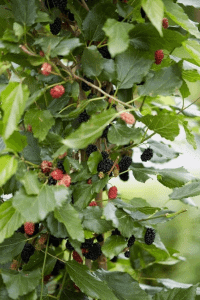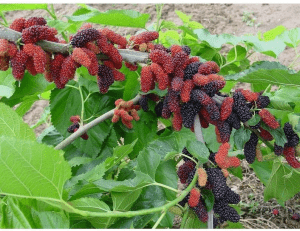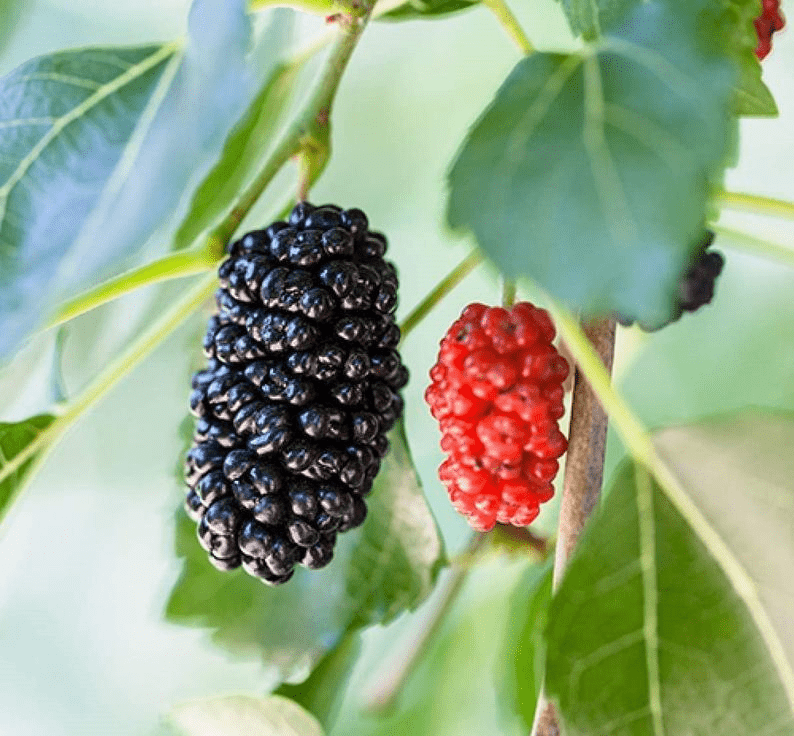The mulberry tree is a fast-growing, large deciduous tree. It provides fruit as well as shade. Some varieties can produce berries the first year. They require minimal care once fully established.
Mulberries are some of the tastiest berries, with a melon-like flavor owing to its low acidity. They make delicious pies, jams, and smoothies too.
Read on to learn about mulberry trees, including history, hardiness, how to plant, care for, and harvest, and the different varieties.
Mulberry Tree Use in the Silk Industry
Mulberry trees originate from China. The Chinese discovered how much silkworms loved to devour the leaves of this tree and that the more they ate, the more silk they produced.
Then in the 1800s and early 1900s, silkworm farming caught on in the United States.
Entrepreneurs and farmers learned how lucrative silk farming was and that the Morus alba, with the white berries, grew well in North America. They grew mulberry trees and raised silkworms.
Unfortunately, silk production in the United States failed to reach the anticipated level of success. This was due to a lack of adequate preparation. They also lacked the knowledge and skills necessary to process cocoons into silk fiber. This lead to the industry’s demise.
Where to Grow Mulberries
Mulberry trees can survive under wide-ranging climatic conditions. Many are drought tolerant and frost tolerant.
To thrive, they require to be planted in full sun and spaced at least 15 feet apart in slightly acidic, moist, well-draining soil. Most varieties will thrive in poor soil as long as it drains well.
Because their root structure can be extensive and aggressive, the soil should be deep enough to accommodate the roots. Be sure to keep them away from driveways, patios, and sidewalks so they don’t break through.
Some varieties are more resilient than others. For example, a white or red mulberry tree are hardier than black mulberry trees.
Most varieties are cold hardy to 0 degrees F (-18C) and will do well in USDA hardiness zones 4 – 9.
If the temperature falls below this range, it will arrest the buds’ sprouting, and if it exceeds, high evapotranspiration will negatively impact plant growth.
They do best with at least 15.5 inches of rainfall (400mm), requiring a maximum of 32 inches of rainfall (800mm) per year.
They grow to a maximum of 80 feet for the taller types, such as the white mulberry, and the shorter ones grow 15 to 20 feet tall.
The red, dark purple and black fruits stain, so if you don’t want berry stains, avoid planting them next to your sidewalk or where you park your car.
How to Grow Mulberry Tree
We do not recommend germinating mulberry seeds. It can be challenging, showing low rates of success. Instead, purchase a mulberry tree from a nursery, garden center, or online.
Plant Mulberry Tree from a Sapling
- Find a location with full sun. Remove the tree from its container.
- Dig a hole as deep as the root ball. The hole should be three times as wide.
- Place the root ball and the dirt from the container into the hole.
- Be sure the tree is standing upright. The top of the root ball should be even with the ground.
- Fill in the hole with existing soil. Be sure the soil is packed down somewhat to help secure and steady the tree.
- Water the soil taking care to not wet the trunk. Add more soil as necessary.
There are dwarf mulberry tree plants you can grow in containers and prune as needed to keep them small.
Mulching
You may want to add mulch around the base of the tree. This will help to conserve moisture. This is especially important in dry climates. If you live in a hot area, mulch will help keep the roots cooler as well. Mulch will also help minimize weeds and grass from growing in the area.
Do You Need Two Mulberry Trees?
One mulberry tree will thrive on its own. You do not need to plant two trees for cross-pollination.
Depending on the variety, some mulberry trees grow male and female flowers which means they are monoecious. The wind pollinates the fruit. They are self-pollinating or self-fertile.
Other mulberry varieties are dioecious. They set fruit without pollination.
While you don’t need to plant two trees, adding a second can dramatically increase the yield if they can cross-pollinate.

Caring for Mulberry Tree
What’s most outstanding about growing a mulberry tree is it requires minimal care.
Watering
It’s important to water your new tree weekly while it becomes established. Then you can start watering once a month. Soon afterwards, rainfall will be enough to keep it thriving.
If you live in a dry climate, you can do a deep soak in months with drought or excessive heat.
Fertilizing
They’re hardy trees that do fine without additional fertilizer. However, to keep them healthy, adding a 10-10-10 fertilizer once a year is a good idea. Apply slow-release fertilizer in the spring. Choose organic fertilizer when possible.
Pruning
It’s not necessary to prune a mulberry tree. You can remove a dead or broken branch in the spring but there is no need to shape the tree or to prune it.
If you are concerned about the size and how they spread, you can remove branches in the spring.
Tree Pests
According to the University of California Agriculture and Natural Resources Statewide Integrated Pest Management Program, these trees can attract:
- Root nematodes
- Foliage-feeding caterpillars such as Fall webworm
- Mealybugs such as Gill’s mealybug, Pink hibiscus mealybug
- Whiteflies such as Mulberry whitefly
Diseases
Take care to ensure there is well-draining soil. Some diseases include:
- Wood decay
- Bacterial blight
- Bacterial leaf scorch
- Armillaria root rot
- Canker diseases
- Nectria canker
- Wetwood
Concerns with Planting
Pollen counts are high and can affect individuals with a pollen allergy. Some areas do not allow people to plant mulberry trees.
Plant trees away from sidewalks, patios and roads as roots can crack the pavement.

Harvesting Mulberries
You harvest mulberries in the summer. Typically, they don’t all ripen at once. This means you can enjoy the fresh mulberries for several weeks.
Generally, ripe berries drop from the trees, but you can shake the tree to encourage them to fall. And because they’re typically in such abundance, it’s best to spread a tarp beneath the tree before shaking it.
Wondering how long they produce fruit? An established tree will produce fruit for 20 years or more.
You can also harvest the leaves to use for tea. The best time to harvest the leaves is in spring and summer. You can pluck individual leaves from the stem. Another method is to prune the shoots by harvesting the leaves.
Why Plant a Mulberry Tree
True, mulberry trees can be a handful. They have aggressive roots, attract insects, create pollen, and stain driveways.
Still, there are reasons you should plant a mulberry tree or two and why permaculture practitioners include these trees in their gardens.
1. Lots of Fruit
Mulberry trees are highly productive. If a bush supplies a lot of fruit, imagine a two-foot bush that’s expanded into a sizable 40-foot tree. It can produce over a hundred pounds of fruit a year.
However, one may wonder why you don’t come across many mulberries in the market. That’s because they’re not commercially viable because of how easily they tend to bruise and leak.
2. Diverse Use
Berries make great snacks and are full of vitamins and dietary fiber. Mulberries can also be preserved by freezing, although they become paste-like. However, that’s okay because you can use them in pie fillings, smoothies, and sauces.
What’s more, they make fruity spreads—jams, jellies, and other preserves. And what’s impressive is they contain pectin in large quantities, which naturally solidifies the preserves.
You can also make wine with them. The fruit is so sweet that you won’t need to add as much honey or sugar as you would with other fruit wines.
But besides the berries, mulberry leaves are also popular in some cultures for medicinal value.
They are edible, although you should always cook them first. You can use them in tea, and, like grape leaves, you can use mulberry leaves to make stuffed leaf recipes.
3. Fast-Growing Trees
Mulberry plants are renowned for shooting up fast, providing fruit early. Some varieties begin to produce berries within their first or second year, slowly yielding more towards maturity (ten years).
4. Good for Beginners
Because they are low maintenance and hardy, they are great for beginner arborists and gardeners as well as green thumbs.
5. Shade
These stately trees will provide abundant shade for your property. Being they are deciduous, they drop their leaves so that by winter they won’t not block out much-needed sunlight.
The leaves grow back in the spring in time for summer when shade is required.
6. Nutritious
This edible fruit is rich in vitamin C, vitamin K, fiber, and iron. They also consist of quite a lot of protein, considering they’re fruits (2 gm per cup). Also, they have a significant amount of calcium, magnesium, and other trace minerals.
Besides being a nutritional powerhouse, mulberries have health-promoting properties. For example, the berries have a lot of antioxidants, which help eliminate disease-causing oxidizing agents.
7. Animal-Friendly
Mulberries are popular with wildlife, too, especially birds, insects, and silkworms. Hence, nature lovers use them to draw birds to their homes and planters to distract animals from their other crops.
This fantastic tree always has an endless supply of berries for nature and its owners.
8. Lifespan
As far as lifespan, the black and white fruited trees can live for hundreds of years. The red mulberry tree lives to 75 years.

Mulberry Tree Varieties
The berries can be red, black or white and many colors in between. The color of the fruit doesn’t determine the mulberry species.
- Morus ruba – They are native to North America and are mostly red.
- Morus nigra – They are native to southwest Asia and the Iberian Peninsula and are typically dark purple and black.
- Lastly, the Morus alba L – According to the USDA Forest Service, in North America, the white hybridizes with the native red mulberry to produce white mulberry fruits.
There are 68 varieties of mulberries found in different parts of the world. Here are some popular varieties:
Beautiful Day
This tree’s berries are also sweet and white. Thus, unlike other mulberries, they don’t stain. They’re eaten fresh or dry as a snack. The tree grows to about 30 feet.
Big White
This mulberry tree is a powerhouse of large white berries that you can consume dried or fresh. The berries ripen very early and play the role of helping to lure birds away from cherries.
They’re hardy enough to survive in up to 100C, and they can live in climate zones 6 – 9.
Black Beauty
This tree produces large, sweet, juicy blackberry-like berries that are black in color. It’s the shortest of mulberry trees, growing to only 15 feet.
Black beauty mulberries grow in zones 4 – 10, ripening over the early summer (late May to early June).
Boysenberry Black
This variety bears long seedless 1½-inch-long black fruit, which makes a tasty jam. The berries ripen in May. They thrive in hardiness zones 7 – 9.
Dwarf Black
This black mulberry of Asian origin is a low-branching dwarf-sized tree that grows to six to ten feet.
Its berries are arguably the sweetest of all with their SweetTart-like flavor. They’re large, soft, and juicy and are available from July to September. Dwarf black mulberries are also the messiest.
They’re not as hardy as other mulberry trees and only grow in zones 7 – 10.
Everbearing
These stately trees will grow to 15 feet and 8 – 10 feet in width when mature. They can fruit in the first year and are easy to grow. They grow in zones 4 – 10.
Himalayan
This very distinctive variety has long, sweet fruit. It does well in the South and on the Pacific coast, with its ability to take heat and humidity.
Illinois Everbearing
This mulberry tree is a very hardy one, able to withstand cold more than its counterparts. It produces long sweet black fruit and can grow in hardiness zones 4 – 9.
Morus alba and Morus nigra
This mulberry tree has heart-shaped leaves and seedless fruits whose size and shape resemble the boysenberries.
It bears fruit early, and the berries are sweet and white (alba) or purple and black (nigra) in color. You can keep these trees as bushes, but some varieties left unpruned can grow 40 feet tall and provide a fantastic shade.
Pakistan
This tree produces extremely long (four inch) large, dark, very flavorful purple berries. It’s moderately hardy and ideal for mild winter climates, although it also does well in cooler climates.
Russian (Murus alba tartarica)
The Russian mulberry, which is native to China, is known to be the hardiest. Its fruits are medium-sized and black, very flavorful, and can be eaten fresh or dried. They also make good jams or pies.
This tree is drought-resistant and makes good firewood. People often use Russian mulberries as windbreaks. They’re seedling trees, meaning they can have female, male, or both flowers in one tree.
When unpruned, they grow to a height of 15 to 20 feet. They’re found in growing zones 3b to 9.
Grow Plants from Mulberry Seeds
Note, it’s really difficult to grow mulberries from seed. It’s best to start from a sapling. If you already have a tree producing fruit and want to grow another tree, follow these steps to grow mulberries from seeds. You will have to be patient with germination.
- Gather ripe berries.
- Soak in water for 24 hours, drain the water, mash the berries to expose the seeds, and then remove them. Alternatively, pour some water onto the mashed fruit to cause the seeds to float and pick them.
- Rinse and dry the seeds, then allow them to air dry in a shady spot.
- After the seeds dry, rinse them a second time. Put the seeds and some damp filter paper in a sealed plastic bag in a refrigerator for 60 to 100 days to allow for stratification to occur.
- After 60 to 100 days, mix equal amounts of soil, peat, and perlite in a tray and place the seeds beneath the soil surface. Try watering the seeds and using a lamp if necessary to ensure they’re at 86 F for eight hours in the daytime and at night, 68 F for 16 hours. The soil should be moist, so keep checking and adding water as is necessary.
- Check if the seeds are germinating. Soon as there are roots, gently take the sprouts and transplant them in individual pots, leaving four-inch spaces to allow adequate room for them to grow into seedlings. Keep the soil moist.
- Move the pots indoors if cold temperatures.
- After 15 to 24 months, move the saplings to their permanent location. Note growing mulberry trees from seeds can take a minimum of five years before they begin producing fruit.
The Mighty Mulberry
Now you know more about the mulberry tree, including their history, their benefits, how to grow, care for, harvest them, and some varieties. Sure they can be invasive and messy, but they also have several uses and benefits.
Planting one or two mulberry trees. It’s an easy way to provide shade on your property while enjoying an abundance fruit. There are also dwarf types of mulberry if you want to grow in a container instead of in the ground.
The path to sustainability is gardens and orchards to supply food. Growing a mulberry tree is one way to ensure a stable food supply. They are easy to grow once established.
Learn about growing fruit and nut trees for your own mini orchard.
- Types of Oranges ~ What Varieties Are Best for Homesteading?
- Kaffir Lime
- Hazelnut Tree Growing Requirements, Maintenance, and More
- Pistachio Tree ~ Where Patience Pays in Pistachios
- Pomegranate Tree

